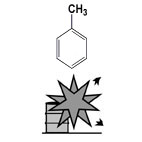| Case Name |
Explosion of a toluene tank due to static electricity on sampling |
| Pictograph |

|
| Date |
January 26, 1976 |
| Place |
Kurashiki, Okayama, Japan |
| Location |
Refinery |
| Overview |
An explosion occurred when sampling with a sampling thief through a gage hatch on the roof of a toluene tank. A combustible gas mixture was generated in the tank vapor layer and ignited by a static electricity discharge in the sampling thief, because countermeasures against electrostatic charge were not taken. It is assumed that toluene generated a combustible gas mixture due to a tank temperature. One person was injured, and the tank was damaged. |
| Incident |
An explosion occurred at a toluene tank of a refinery when sampling was conducted from the tank roof. |
| Processing |
Storage |
| Substance |
Toluene, Fig2 |
| Type of Accident |
Explosion |
| Sequence |
An operator climbed onto the tank roof, opened a gage hatch, suspended a sampling thief into the tank, and gathered toluene in the tank for washing the sampling thief. Then he started sampling. At the first sampling, the sampling thief reached the tank bottom without a plug, and pulled to the top of the tank at a high speed. The operator emptied the sample into a glass bottle, with wearing rubber gloves.
At the 2nd sampling, when the sampling thief was suspended into the tank, an explosion occurred before the sampling thief reached the liquid level, and the tank top was deformed. |
| Cause |
The cause of the explosion was static electricity spark discharge. The sampling thief produced the electrostatic charge when it was pulled up quickly at the first time. The sampling thief was electrified because it was not grounded, and because it was handled using rubber gloves and a cotton lifting rope. The static electricity was discharged at the entrance of the gage hatch when the next sampling was done. A combustible gas mixture had been formed by the tank temperature. |
| Response |
Water was sprayed by a private fire brigade. |
| Countermeasures |
It is necessary that countermeasures against static electricity should be taken when sampling from a tank roof is conducted. Concretely, electricity of a sampling operator has to be removed correctly, a lifting rope has to be electro-conductive and grounded correctly, and the speed of pulling up the sampling thief has to be slow.
If possible, another sampling method should be adopted instead of the sampling thief method from the tank roof.
An operation standard has to be made, and sufficient education has to be carried out. |
| Knowledge Comment |
Sufficient electrostatic charge prevention measures must be taken when a sample is taken from a vapor layer, such as at the upper part of a tank. |
| Background |
There seems to have been ignorance or a job instruction violation. Concretely, "countermeasures against static electricity were not taken." |
| Incidental Discussion |
Static electricity is generated during transfer into the tank, and the tank is electrified. In particular, for a combustible liquid whose electrical resistance is over 10^10 Ω cm, limitations on flow speed into the tank and standing time for sampling should be imposed. A nitrogen blanket for the tank is very effective for safety. Initial velocity restrictions on starting to transfer necessary for all types of oil, and it should be 1m/sec. or less. |
| Reason for Adding to DB |
Example of explosion caused due to lack of countermeasures against static electricity on sampling |
| Scenario |
| Primary Scenario
|
Organizational Problems, Poor Management, Poor Operation Management, Poor Value Perception, Poor Safety Awareness, Inadequate Risk Recognition, Organizational Problems, Inflexible Management Structure, Insufficient Education/Training, Ignorance, Insufficient Knowledge, No Consideration, No Thinking, Malicious Act, Rule Violation, Safety Rule Violation, Bad Event, Thermo-Fluid Event, Static Electricity Charge, Secondary Damage, External Damage, Explosion, Bodily Harm, Injury, Loss to Organization, Economic Loss, Manetary Damage 4 million yen
|
|
| Sources |
Fire and Disaster Management Agency. Examples of accidents at manufacturers of dangerous materials, 1976. pp.130-131.
Tetsuzo Kitagawa, Explosion when sampling toluene and xylene. Analysis of explosion hazard. pp.70-73(1980).
|
| Number of Injuries |
1 |
| Physical Damage |
Deformation of a toluene tank top |
| Financial Cost |
¥ 3 million. (Fire and Disaster Management Agency) |
| Multimedia Files |
Fig2.Chemical formula
|
| Field |
Chemicals and Plants
|
| Author |
KOBAYASHI, Mitsuo (Office K)
TAMURA, Masamitsu (Center for Risk Management and Safety Sciences, Yokohama National University)
|
|